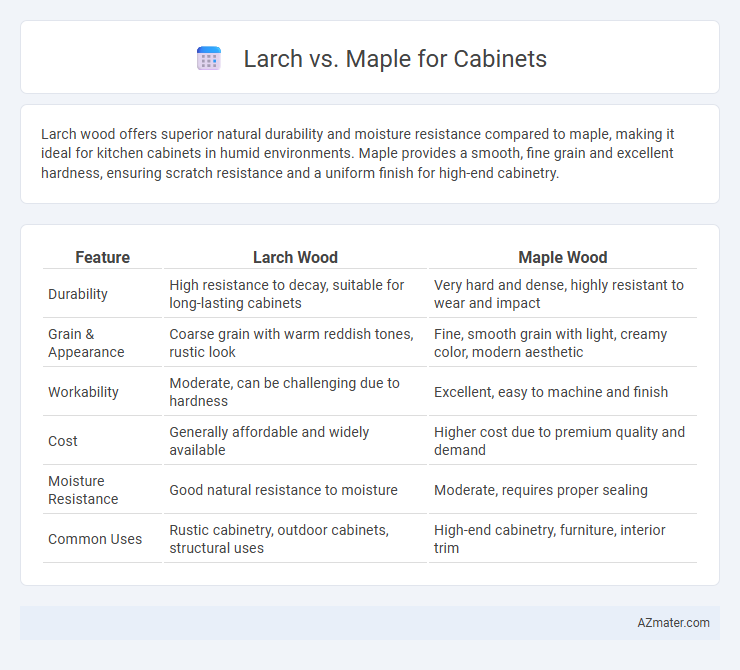Larch wood offers superior natural durability and moisture resistance compared to maple, making it ideal for kitchen cabinets in humid environments. Maple provides a smooth, fine grain and excellent hardness, ensuring scratch resistance and a uniform finish for high-end cabinetry.
Table of Comparison
| Feature | Larch Wood | Maple Wood |
|---|---|---|
| Durability | High resistance to decay, suitable for long-lasting cabinets | Very hard and dense, highly resistant to wear and impact |
| Grain & Appearance | Coarse grain with warm reddish tones, rustic look | Fine, smooth grain with light, creamy color, modern aesthetic |
| Workability | Moderate, can be challenging due to hardness | Excellent, easy to machine and finish |
| Cost | Generally affordable and widely available | Higher cost due to premium quality and demand |
| Moisture Resistance | Good natural resistance to moisture | Moderate, requires proper sealing |
| Common Uses | Rustic cabinetry, outdoor cabinets, structural uses | High-end cabinetry, furniture, interior trim |
Overview of Larch and Maple Wood
Larch wood, known for its durability and natural resistance to moisture, features a coarse grain and warm reddish-brown color, making it ideal for sturdy, rustic cabinets. Maple wood is prized for its fine, uniform texture and light creamy hue, offering excellent strength and smooth finish that suits modern, high-end cabinetry. Both woods provide robust performance, with larch excelling outdoors due to rot resistance and maple favored for its versatility and ease of staining.
Appearance and Grain Differences
Larch wood features a pronounced, rugged grain with warm reddish-brown tones and distinct knots, offering a rustic and textured appearance ideal for cabin-style cabinets. Maple presents a smoother, tighter grain pattern with consistent light cream to pale reddish hues, providing a clean, modern look perfect for sleek, contemporary cabinetry. The choice between larch's natural, varied aesthetic and maple's uniform, refined finish significantly influences the overall design impact of kitchen or bathroom cabinets.
Durability and Hardness Comparison
Larch wood offers moderate durability and hardness, making it resistant to wear and suitable for cabinet construction in environments with occasional moisture exposure. Maple is significantly harder and denser, providing superior durability and scratch resistance, ideal for high-traffic kitchen cabinets. The Janka hardness rating of maple averages around 1,450, while larch typically rates near 830, indicating maple's advantage in longevity and structural integrity for cabinetry.
Cost and Availability
Larch wood cabinets typically cost less than maple due to its faster growth and more abundant availability in colder climates. Maple is generally more expensive because of its finer grain and higher durability, and it is more widely available in North America. Both woods provide sturdy cabinet options, but larch offers budget-friendly pricing with easier sourcing in specific regions.
Workability and Ease of Installation
Larch offers excellent workability due to its straight grain and medium density, allowing for smooth cutting, shaping, and sanding, making it a reliable choice for cabinetry. Maple is harder and denser, which can increase tool wear and requires pre-drilling for screws, but it provides a very smooth finish and strong, durable joints once installed. While larch is easier to install and manipulate during construction, maple excels in long-term durability and a refined aesthetic in cabinet-making projects.
Staining and Finishing Properties
Larch wood offers a rich, resinous grain with excellent stain absorption that enhances its natural warmth, making it ideal for cabinets requiring a durable finish resistant to moisture. Maple is known for its tight, uniform grain, providing a smooth surface that evenly accepts stains but can sometimes result in blotchy finishes without proper pre-treatment such as conditioner application. Both woods respond well to clear finishes, but larch's inherent oils contribute to a longer-lasting finish, while maple's hardness and fine grain yield a refined, polished appearance when finished correctly.
Environmental Impact and Sustainability
Larch wood, harvested from fast-growing conifers, offers superior sustainability due to its rapid regeneration and lower environmental footprint compared to Maple, which grows slower and requires more intensive forestry management. Larch's natural resistance to decay reduces the need for chemical treatments, enhancing its eco-friendliness in cabinet construction. Maple, being a hardwood, provides durability but often involves higher energy consumption in processing, making Larch a more environmentally responsible choice for sustainable cabinetry.
Maintenance and Longevity
Larch offers natural resistance to decay and insects, reducing maintenance frequency compared to Maple, which is more vulnerable and often requires regular sealing or finishing. Maple's dense grain provides durability and longevity, but it may show wear more quickly in high-traffic areas without proper upkeep. Both woods benefit from periodic cleaning and refinement, yet Larch generally offers a longer lifespan with less intensive maintenance.
Best Applications in Cabinet Design
Larch wood offers exceptional durability and natural resistance to moisture, making it ideal for cabinets in kitchens and bathrooms where humidity levels are higher. Maple features a smooth, fine grain and light color, providing a clean, modern aesthetic that suits contemporary cabinet designs. For cabinetry requiring both strength and a sophisticated finish, maple is preferred, while larch excels in rustic or outdoor-inspired cabinets due to its rugged texture and resilience.
Choosing the Right Wood for Your Cabinets
Larch wood offers exceptional durability and a rich reddish hue, making it ideal for cabinets that require sturdiness and a warm, natural look. Maple features a smooth grain and lighter color, providing a sleek, modern appearance with excellent resistance to dents and scratches. Selecting between larch and maple depends on the desired cabinet style, durability needs, and color preference, with larch excelling in rustic designs and maple suited for contemporary, clean aesthetics.

Infographic: Larch vs Maple for Cabinet
 azmater.com
azmater.com